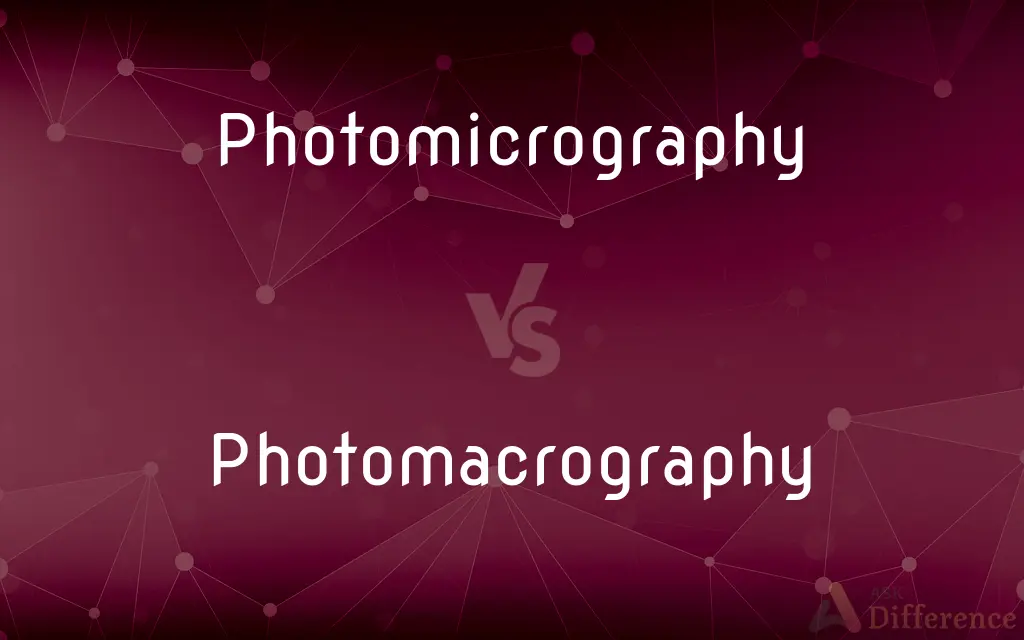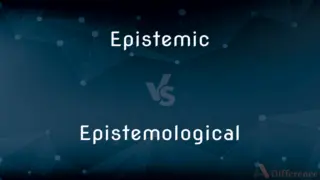Photomicrography vs. Photomacrography — What's the Difference?
By Urooj Arif & Fiza Rafique — Updated on May 6, 2024
Photomicrography involves capturing highly magnified images using a microscope, while photomacrography, or macro photography, involves taking extremely detailed pictures of small subjects without magnification typical of microscopes.

Difference Between Photomicrography and Photomacrography
Table of Contents
ADVERTISEMENT
Key Differences
Photomicrography is a technique used to take images at microscopic scales, typically involving magnifications that exceed the capabilities of the human eye to resolve detail unaided. This process often involves specialized microscopes equipped with camera systems. On the other hand, photomacrography, often simply known as macro photography, captures detailed photographs of small subjects at close range but at a scale where features are visible to the naked eye, usually with magnifications ranging from 1:1 (life size) to about 10:1, which is still significantly less than microscope levels.
In photomicrography, the subjects are generally cellular structures, minerals, and microorganisms, which require significant magnification to be visible. The equipment used includes various types of microscopes, such as compound, stereo, and electron microscopes, each providing different levels of detail and types of images. Conversely, photomacrography often focuses on slightly larger subjects like insects, flowers, and small objects, using standard cameras with macro lenses, which are designed to achieve a greater focusing capability at close distances.
The lighting techniques also differ significantly between the two. Photomicrography may use transmitted light, polarized light, or fluorescence to illuminate the subject, depending on the type of microscopy. Photomacrography typically uses natural light or external flash units to enhance the lighting on the subject, focusing on achieving depth of field and highlighting texture and color.
The applications of photomicrography are predominantly scientific, contributing to fields such as biology, materials science, and medical diagnosis. It allows for the visualization of structures too small to be seen with the naked eye. Photomacrography, while it can be used for scientific purposes like entomology, often leans more towards artistic photography, where the emphasis is on aesthetic qualities and intricate details of everyday objects at a small scale.
The challenges faced in each type of photography differ; photomicrography requires a thorough understanding of the microscopic world and the technical skills to handle complex microscopy equipment. Photomacrography, while technically easier, demands artistic skill and the ability to manipulate depth of field and lighting to capture the subject’s intricate details effectively.
ADVERTISEMENT
Comparison Chart
Magnification
High magnification, beyond naked eye visibility.
Lower magnification, usually up to 10:1.
Typical Subjects
Cellular structures, minerals, microorganisms.
Insects, flowers, small objects.
Equipment Used
Microscopes with camera systems.
Cameras with macro lenses.
Lighting Techniques
Specialized lighting based on microscope type.
Natural light or external flashes.
Primary Applications
Scientific research and medical diagnostics.
Both artistic and some scientific applications.
Focus on
Detail visibility at a microscopic level.
Aesthetic qualities at close range.
Compare with Definitions
Photomicrography
Focuses on revealing unseen worlds.
Photomicrography provided clear images of the mineral's crystalline structure.
Photomacrography
Shows life-size or slightly enlarged details.
His photomacrography captured the vibrant colors of the butterfly.
Photomicrography
Essential in scientific labs.
Researchers used photomicrography to observe the cellular changes.
Photomacrography
Combines detail with aesthetic.
The photomacrography exhibit showcased exquisite natural patterns.
Photomicrography
Involves complex microscopy techniques.
The lab upgraded its equipment for advanced photomicrography.
Photomacrography
Uses readily available cameras and lenses.
She used a DSLR with a macro lens for her garden shoot.
Photomicrography
Capturing images of structures not visible to the naked eye.
Photomicrography revealed the intricate details of the virus.
Photomacrography
Highlights intricate details beautifully.
Photomacrography revealed the texture of the leaf’s surface.
Photomicrography
Used for recording and analysis.
The study’s findings were supported by photomicrographs.
Photomacrography
Critical for artistic effect.
He adjusted the depth of field to focus on the insect’s eyes.
Photomicrography
A photograph made by means of a microscope. Also called microphotograph.
Photomacrography
(photography) The photography of small objects, at close range, using a macro lens.
Photomicrography
To photograph (an object) by means of a microscope.
Photomicrography
(photography) Photography using a microscope.
Photomicrography
The art of producing photomicrographs.
Common Curiosities
What is photomicrography used for?
Primarily for scientific and medical research, enabling detailed study of microscopic entities.
How does photomacrography differ from regular photography?
It focuses on much smaller subjects, providing greater detail and requiring specific techniques for close-up images.
How important is lighting in photomacrography?
Extremely important, as proper lighting brings out the texture and color of small subjects.
Can photomicrography be done with any microscope?
While many microscopes can be adapted for photomicrography, specialized equipment is often required for high-quality images.
What kind of camera is best for photomacrography?
DSLR or mirrorless cameras with dedicated macro lenses are ideal for high-quality macro images.
Can photomicrography reveal the structure of viruses?
Yes, with the right type of electron microscopy, photomicrography can reveal detailed structures of viruses and other nano-scale particles.
What are common subjects for photomacrography?
Common subjects include plants, insects, and everyday objects, focusing on their fine details.
What is the biggest challenge in photomicrography?
Managing the technical aspects of microscopy and capturing clear, detailed images at such small scales.
What does a macro lens do?
A macro lens allows closer focusing distances and is optimized for high reproduction ratios, ideal for capturing detailed close-up photos.
How do you achieve depth of field in photomacrography?
By adjusting aperture settings and the distance between the camera and the subject, while sometimes using focus stacking techniques.
Share Your Discovery

Previous Comparison
Funny vs. Funky
Next Comparison
Epistemic vs. EpistemologicalAuthor Spotlight
Written by
Urooj ArifUrooj is a skilled content writer at Ask Difference, known for her exceptional ability to simplify complex topics into engaging and informative content. With a passion for research and a flair for clear, concise writing, she consistently delivers articles that resonate with our diverse audience.
Co-written by
Fiza RafiqueFiza Rafique is a skilled content writer at AskDifference.com, where she meticulously refines and enhances written pieces. Drawing from her vast editorial expertise, Fiza ensures clarity, accuracy, and precision in every article. Passionate about language, she continually seeks to elevate the quality of content for readers worldwide.
















































